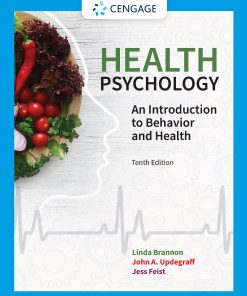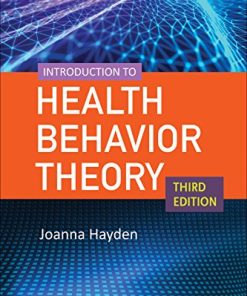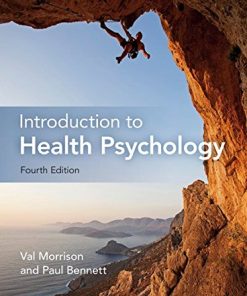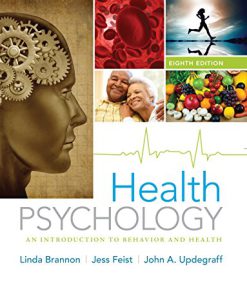(Ebook PDF) Health Psychology An Introduction to Behavior and Health 9th Edition by Linda Brannon 9798214345116 full chapters
$50.00 Original price was: $50.00.$25.00Current price is: $25.00.
Health Psychology: An Introduction to Behavior and Health 9th Edition by Linda Brannon – Ebook PDF Instant Download/DeliveryISBN: 9798214345116
Full download Health Psychology: An Introduction to Behavior and Health 9th Edition after payment.
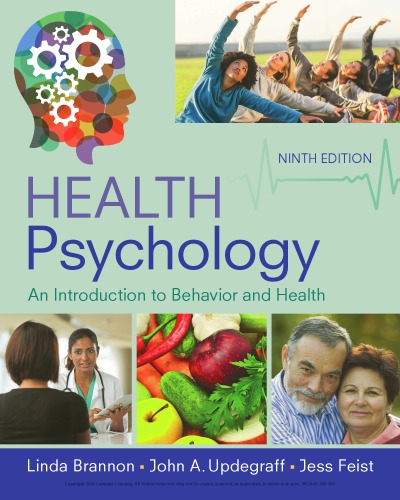
Product details:
ISBN-13 : 9798214345116
Author: Linda Brannon
For over 20 years, HEALTH PSYCHOLOGY: AN INTRODUCTION TO BEHAVIOR AND HEALTH has remained a leader in the field for its scholarship, strong and current research base, and balanced coverage of the cognitive, behavioral, and biological approaches to health psychology. Accessible and appealing to a wide-range of students — including non-majors — this classic text features a concise writing style, ample pedagogy, and numerous visuals to support your learning and understanding. This edition is updated to reflect the latest developments in the field, and includes many new real-world examples selected for their interest and relevance.
Health Psychology: An Introduction to Behavior and Health 9th Table of contents:
Chapter 1. Introducing Health Psychology
The Changing Field of Health
Patterns of Disease and Death
Escalating Cost of Medical Care
What Is Health?
Psychology’s Relevance for Health
The Contribution of Psychosomatic Medicine
The Emergence of Behavioral Medicine
The Emergence of Health Psychology
The Profession of Health Psychology
The Training of Health Psychologists
The Work of Health Psychologists
Suggested Readings
Chapter 2. Conducting Health Research
The Placebo in Treatment and Research
Treatment and the Placebo
Research and the Placebo
Research Methods in Psychology
Correlational Studies
Cross-Sectional and Longitudinal Studies
Experimental Designs
Ex Post Facto Designs
Research Methods in Epidemiology
Observational Methods
Randomized Controlled Trials
Meta-Analysis
An Example of Epidemiological Research: The Alameda County Study
Determining Causation
The Risk Factor Approach
Cigarettes and Disease: Is There a Causal Relationship?
Research Tools
The Role of Theory in Research
The Role of Psychometrics in Research
Suggested Readings
Chapter 3. Seeking and Receiving Health Care
Seeking Medical Attention
Illness Behavior
The Sick Role
Seeking Medical Information from Nonmedical Sources
Lay Referral Network
The Internet
Receiving Medical Care
Limited Access to Medical Care
Choosing a Practitioner
Being in the Hospital
Suggested Readings
Chapter 4. Adhering to Healthy Behavior
Issues in Adherence
What Is Adherence?
How Is Adherence Measured?
How Frequent Is Nonadherence?
What Are the Barriers to Adherence?
What Factors Predict Adherence?
Severity of the Disease
Treatment Characteristics
Personal Factors
Environmental Factors
Interaction of Factors
Why and How Do People Adhere to Healthy Behaviors?
Continuum Theories of Health Behavior
Stage Theories of Health Behavior
The Intention–Behavior Gap
Behavioral Willingness
Implementational Intentions
Improving Adherence
Suggested Readings
Chapter 5. Defining, Measuring, and Managing Stress
The Nervous System and the Physiology of Stress
The Peripheral Nervous System
The Neuroendocrine System
Physiology of the Stress Response
Theories of Stress
Selye’s View
Lazarus’s View
Sources of Stress
Cataclysmic Events
Life Events
Daily Hassles
Measurement of Stress
Methods of Measurement
Coping with Stress
Personal Resources That Influence Coping
Personal Coping Strategies
Behavioral Interventions for Managing Stress
Relaxation Training
Cognitive Behavioral Therapy
Emotional Disclosure
Mindfulness
Suggested Readings
Chapter 6. Understanding Stress, Immunity, and Disease
Physiology of the Immune System
Organs of the Immune System
Function of the Immune System
Immune System Disorders
Psychoneuroimmunology
History of Psychoneuroimmunology
Research in Psychoneuroimmunology
Physical Mechanisms of Influence
Does Stress Cause Disease?
The Diathesis–Stress Model
Stress and Disease
Stress and Psychological Disorders
Suggested Readings
Chapter 7. Understanding and Managing Pain
Pain and the Nervous System
The Somatosensory System
The Spinal Cord
The Brain
Neurotransmitters and Pain
The Modulation of Pain
The Meaning of Pain
Definition of Pain
The Experience of Pain
Theories of Pain
Pain Syndromes
Headache Pain
Low Back Pain
Arthritis Pain
Cancer Pain
Phantom Limb Pain
The Measurement of Pain
Self-Reports
Behavioral Assessments
Physiological Measures
Managing Pain
Medical Approaches to Managing Pain
Behavioral Techniques for Managing Pain
Suggested Readings
Chapter 8. Considering Alternative Approaches
Alternative Medical Systems
Traditional Chinese Medicine
Ayurvedic Medicine
Alternative Products and Diets
Manipulative Practices
Chiropractic Treatment
Massage
Mind–Body Medicine
Mind–Body Medicine
Meditation and Yoga
Qi Gong and Tai Chi
Biofeedback
Hypnotic Treatment
Physiology and Mind–Body Medicine
Who Uses Complementary and Alternative Medicine?
Culture, Ethnicity, and Gender
Motivations for Seeking Alternative Treatment
How Effective Are Alternative Treatments?
Alternative Treatments for Anxiety, Stress, and Depression
Alternative Treatments for Pain
Alternative Treatments for Other Conditions
Limitations of Alternative Therapies
Integrative Medicine
Suggested Readings
Chapter 9. Behavioral Factors in Cardiovascular Disease
The Cardiovascular System
The Coronary Arteries
Coronary Artery Disease
Stroke
Blood Pressure
The Changing Rates of Cardiovascular Disease
Reasons for the Decline in Death Rates
Heart Disease Throughout the World
Risk Factors in Cardiovascular Disease
Inherent Risk Factors
Physiological Conditions
Behavioral Factors
Psychosocial Factors
Reducing Cardiovascular Risks
Before Diagnosis: Preventing First Heart Attacks
After Diagnosis: Rehabilitating Cardiac Patients
Suggested Readings
Chapter 10. Behavioral Factors in Cancer
What Is Cancer?
The Changing Rates of Cancer Deaths
Cancers with Decreasing Death Rates
Cancers with Increasing Incidence and Mortality Rates
Cancer Risk Factors beyond Personal Control
Inherent Risk Factors for Cancer
Environmental Risk Factors for Cancer
Behavioral Risk Factors for Cancer
Smoking
Diet
Alcohol
Sedentary Lifestyle
Ultraviolet Light Exposure
Sexual Behavior
Psychosocial Risk Factors in Cancer
Living with Cancer
Problems with Medical Treatments for Cancer
Adjusting to a Diagnosis of Cancer
Social Support for Cancer Patients
Psychological Interventions for Cancer Patients
Suggested Readings
Chapter 11. Living with Chronic Illness
The Impact of Chronic Disease
Impact on the Patient
Impact on the Family
Living with Alzheimer’s Disease
Helping the Patient
Helping the Family
Adjusting to Diabetes
The Physiology of Diabetes
The Impact of Diabetes
Health Psychology’s Involvement with Diabetes
The Impact of Asthma
The Disease of Asthma
Managing Asthma
Dealing with HIV and AIDS
Incidence and Mortality Rates for HIV/AIDS
Symptoms of HIV and AIDS
The Transmission of HIV
Psychologists’ Role in the HIV Epidemic
Facing Death
Adjusting to Terminal Illness
Grieving
Suggested Readings
Chapter 12. Smoking Tobacco
Smoking and the Respiratory System
Functioning of the Respiratory System
What Components in Smoke Are Dangerous?
A Brief History of Tobacco Use
Choosing to Smoke
Who Smokes and Who Does Not?
Why Do People Smoke?
Health Consequences of Tobacco Use
Cigarette Smoking
Cigar and Pipe Smoking
E-Cigarettes
Passive Smoking
Smokeless Tobacco
Interventions for Reducing Smoking Rates
Deterring Smoking
Quitting Smoking
Who Quits and Who Does Not?
Relapse Prevention
Effects of Quitting
Quitting and Weight Gain
Health Benefits of Quitting
Suggested Readings
Chapter 13. Using Alcohol and Other Drugs
Alcohol Consumption—Yesterday and Today
A Brief History of Alcohol Consumption
The Prevalence of Alcohol Consumption Today
The Effects of Alcohol
Hazards of Alcohol
Benefits of Alcohol
Why Do People Drink?
The Disease Model
Cognitive-Physiological Theories
The Social Learning Model
Changing Problem Drinking
Change Without Therapy
Treatments Oriented Toward Abstinence
Controlled Drinking
The Problem of Relapse
Other Drugs
Health Effects
Drug Misuse and Abuse
Treatment for Drug Abuse
Preventing and Controlling Drug Use
Suggested Readings
Chapter 14. Eating and Weight
The Digestive System
Factors in Weight Maintenance
Experimental Starvation
Experimental Overeating
Overeating and Obesity
What Is Obesity?
Why Are Some People Obese?
How Unhealthy Is Obesity?
Dieting
Approaches to Losing Weight
Is Dieting a Good Choice?
Eating Disorders
Anorexia Nervosa
Bulimia
Binge Eating Disorder
Suggested Readings
Chapter 15. Exercising
Types of Physical Activity
Reasons for Exercising
Physical Fitness
Weight Control
Physical Activity and Cardiovascular Health
Early Studies
Later Studies
Do Women and Men Benefit Equally?
Physical Activity and Cholesterol Levels
Other Health Benefits of Physical Activity
Protection against Cancer
Prevention of Bone Density Loss
Control of Diabetes
Psychological Benefits of Physical Activity
Hazards of Physical Activity
Exercise Addiction
Injuries from Physical Activity
Death during Exercise
Reducing Exercise Injuries
How Much Is Enough but Not Too Much?
Improving Adherence to Physical Activity
Informational Interventions
Suggested Readings
Chapter 16. Future Challenges
Challenges for Healthier People
Increasing the Span of Healthy Life
Reducing Health Disparities
Outlook for Health Psychology
Progress in Health Psychology
Future Challenges for Health Care
Will Health Psychology Continue to Grow?
Making Health Psychology Personal
Understanding Your Risks
People also search for Health Psychology: An Introduction to Behavior and Health 9th:
health behaviour model theory
introduction to health behavior theory
what is health behaviour in psychology
what is behavioral health psychology
basic beliefs of behavioral psychology
Tags:
Health Psychology,Introduction,Behavior,Health,Linda Brannon
You may also like…
Uncategorized
(eTextbook PDF) for Introduction to One Health: An Interdisciplinary Approach to Planetary Health
Medicine & Health Science
An Introduction to Global Health Delivery 1st Edition, (Ebook PDF)
Relationships & Lifestyle - Diet & Nutrition
Education Studies & Teaching - Education - General & Miscellaneous
Uncategorized





